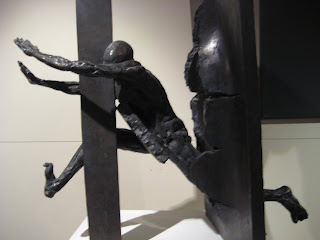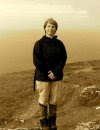
We also went to the Sadu museum. This is the traditional Bedouin weaving museum. It was full of lovely weavings. While we were there, a group of chatty young girls came in to have their weaving lesson, and they seemed very excited about it!

We went to the national museum in a tremendous dust storm. It was eerie to walk around the windy, dusty abandoned courtyard. The national museum had some fairly unlabeled faintly organized archeological exhibits from digs on Failaka Island which dated back to 3,000 BC. Evidently there was water on this island and it was a verdant lovely place to live and trade with local boat traffic. That was until the Iraqi invasion when everybody was moved off the island and the beaches were mined. Now there is a small beach resort and strange heritage village on the island, but the town is a ghost town. More on Failaka in another post.
The national museum also houses a "heritage village" that is a warren of little alleys to emulate a souk with little stalls inhabited by mannikins in awkward ethic craft poses. This is followed by an eclectic collection of artifacts from the 20th century like a bunch of stringed instruments, many typewriters, some bakelite telephones, and lots of coffee pots. I had heard that in the invasion, the Iraqis had looted the museum but by now 90% of the original catalog had been returned. However, these artifacts must have been on loan somewhere because we did not see anything that looked like it might have warranted looting.
We also visited the planetarium at the national museum. We asked for the English language galaxies show, which was really cool as it showed excellent pictures from the Hubble telescope. However, if I may nitpick a bit, the cheesy introduction suggested that the history of astronomy began with the European renaissance, and I happen to know that Galileo et al were all reading the works of astronomers from this part of the world to inform their work. In fact, Galileo wrote in Arabic script. In the Sharja museum in the UAE, there is an extensive astronomical technology exhibit from well before the European Renaissance. I found it odd that the Smithsonian Institute, who claimed to have made this planetarium show, did not know about the Arab astronomers.
 We also visited the Museum of National Memoriam which documents the Iraqi invasion. It is principally dioramas that re-enact the progression and atrocities of the invasion of 1990. It was quite traumatic, not just to learn about the minutia of the atrocities but to be assaulted by the very loud simulated air raid, machine gun, tank, and screaming sounds that went with each installation. After the dioramas came the individual memoria to the people who died or were POWs. It was heart wrenching to view the pictures. I asked several young people we met if they had gone, and they said, all their schools had taken them there as a field trip, but many said they did not really pay a lot of attention: they remembered it was loud and dark, and one young lady said, very softly, "It made me hate Iraq."
We also visited the Museum of National Memoriam which documents the Iraqi invasion. It is principally dioramas that re-enact the progression and atrocities of the invasion of 1990. It was quite traumatic, not just to learn about the minutia of the atrocities but to be assaulted by the very loud simulated air raid, machine gun, tank, and screaming sounds that went with each installation. After the dioramas came the individual memoria to the people who died or were POWs. It was heart wrenching to view the pictures. I asked several young people we met if they had gone, and they said, all their schools had taken them there as a field trip, but many said they did not really pay a lot of attention: they remembered it was loud and dark, and one young lady said, very softly, "It made me hate Iraq." On a less traumatic note, we visited the Tareq Rajab Museum. This is a private home made into a museum for the private collection of Tareq Rajab. He was the first director of the Department of Antiquities in Kuwait and was an avid collector. The museum has a large collection organized according to the 19th century British catalog system: put things with the same shape together in the same place. It is a varied and lovely collection almost entirely unencumbered by text. The silver jewelry is lovely, the collection of ornamented flintlock rifles is astounding, and the traditional costumes are beautiful. They have a whole section devoted to the country of Palestine.
 The most exquisite of the museums was the calligraphy museum. It had a riveting video about how to make the ink and reed pens. The pieces were so beautiful that I was re-inspired to continue my Arabic studies. There was also a collection of Arabic calligraphy done by a Chinese artist.
The most exquisite of the museums was the calligraphy museum. It had a riveting video about how to make the ink and reed pens. The pieces were so beautiful that I was re-inspired to continue my Arabic studies. There was also a collection of Arabic calligraphy done by a Chinese artist.  But what about modern art? Is there any in Kuwait, or is it all just heritage crafts, and with modernity art died in Kuwait? Mais non! We visited the modern art museum, much to the surprise of the single docent. Much of the modern art displayed in the museum seemed to date to the 70s and 80s, but there were some 21st century pieces there also. I thought the most striking pieces seemed to come from the sculptors who were responding Kuwait's struggle to find itself in the 80s and recover itself in the 90s. This was the most evocative piece for me by the artist Sami Mohammed, dated 1989.
But what about modern art? Is there any in Kuwait, or is it all just heritage crafts, and with modernity art died in Kuwait? Mais non! We visited the modern art museum, much to the surprise of the single docent. Much of the modern art displayed in the museum seemed to date to the 70s and 80s, but there were some 21st century pieces there also. I thought the most striking pieces seemed to come from the sculptors who were responding Kuwait's struggle to find itself in the 80s and recover itself in the 90s. This was the most evocative piece for me by the artist Sami Mohammed, dated 1989. 
So yes, Kuwait has local art, and there is community involvement. It is not very well advertised, but it is there, and it is all worth going to see. The Amideast organizers have done a great job organizing all these visits, and I have learned so much at each one.



1 comment:
I'm planning to book a flight going to Kuwait for a vacation, just for a change ;) and thanks for sharing this great Museum, I'll surely go and visit that..
Kuwait Apartments
Post a Comment